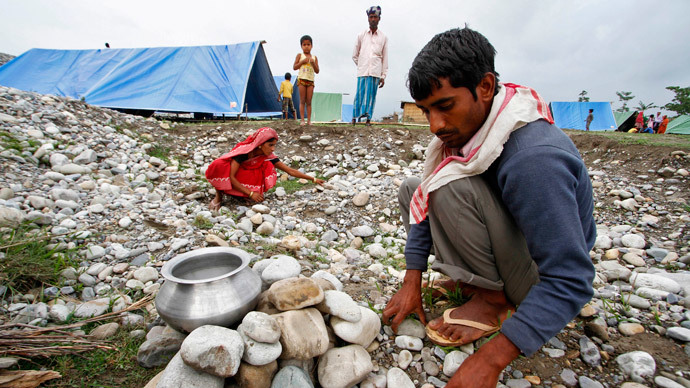Bangladesh migrants, the citizens of no man’s land

As India prepares to be led by the new Narendra Modi government, the 2014 election will be remembered, in the politics of world’s largest democracy, as an era that wriggled new realities.
From the near complete wipe out of the Gandhis’ hold – who have given the country three of its prime ministers - on Indian politics, to the Bharatiya Janata Party (BJP) making inroads into new regions like the north eastern state of Assam known to be the Congress ‘fortress’.
Assam has been returning Congress to power for a long time. What then could have prompted BJP to a resounding victory in 7 out of 14 constituencies in the state?
Usually a topic brushed aside by the political parties of India, the BJP campaigns strike a special cord with people by taking up the issue of illegal migration from Bangladesh into the north eastern part of India especially Assam which borders Bangladesh.
Pegged at over 20 million in India these migrants – mostly Muslims from Bangladesh – have been permanently settling down in Assam which has impacted the state’s demography reducing the ethnic people of Assam into a minority in many areas, declining land availability and employment and increasing the crime rate.
Threatened of losing their dominance, the ethnic groups of the region have been up in arms against these migrants, many times resulting in blood spattered battles. The latest being between Bodos, the region’s biggest tribal group, and Muslim settlers believed to have migrated from Bangladesh. About 38 Muslims were killed by Bodo militants. A similar violent outbreak took place in 2012 claiming 42 lives and displacing thousands.
The entire incident is given a communal overtone said to have been provoked after Narendra Modi’s campaigns in East India including West Bengal (which also receives a sizeable number of migrants from Bangladesh) and Assam where he reiterated that people from Bangladesh who illegally cross the border should be deported.
However this has a deeper insinuation than just a religious tinge. It is the agitation of indigenous settlers getting marginalized in their own land. Explaining the stance of the BJP, Dr Ajai Sahni, Executive Director, Institute for Conflict Management & South Asia Terrorism Portal says, “Though the BJP has always made a distinction between the Hindus and Muslims emigrating from Bangladesh considering the former as refugees and terming the later as illegal immigrants, it has termed the clashes as migrants versus locals and not Hindus versus Muslims.”
India shares its longest international border, measuring 4,096.7 km, with its eastern neighbor Bangladesh. Eastern regions of India like West Bengal, Assam, Tripura are the bordering states.
The flow of migrants to India from Bangladesh dates back to 1947 when many fled to Assam and West Bengal from East Pakistan (current Bangladesh) – especially the Hindus –to escape the wrath of the then Pakistani military. This intensified during the Bangladesh Liberation War in 1971. It is estimated that about 10 million people migrated to India. While many returned after the war, a sizeable number stayed behind.
Migrants who crossed over to India on or before 25 March 1971 were conferred‘refugee’ status and subsequently granted citizenship by the Government of India. Those crossing the bordering after this are largely considered illegal migrants with the case of persecution of religious minorities in Bangladesh being an exception.

Incessant migration
It is the economic migration to the country that is creating unrest. Recent decades have seen a rise in border crossing by Bangladeshis, belonging to the majority Bengali speaking Muslim community, to escape economic impoverishment.
Almost 80 percent of Bangladesh’s population lives in the rural areas, of which 53 percent are classified as poor by the World Bank. While the country’s population is growing, producing a bigger labor force, the land base is shrinking resulting in decline in cultivated areas at a rate of 1 percent per year.
The country is facing serious issues with living space due to alarming population growth. As per 2011 estimates, the population density of Bangladesh is 964 per sq km, one of the highest in the world.
This poverty stricken population illegally migrates to India to work as farm labor, industrial labor, construction workers etc.
These migrant settlers constitute a majority in many parts of Assam bordering Bangladesh, reducing local tribes to a minority. For instance Dhubri, on the Indo-Bangladesh border and point of entry for Bangladeshis, has Bengali-speaking Muslims rising from 70.45 per cent in 1991 to 76 per cent according to the 2011 Census, in contrast to a marginal growth of the indigenous Assamese-speaking Muslims.
Dr Sahni adds, “Illegal immigration itself has an internal dynamics within the Muslim population in Assam, where the Assamese Muslims also feel increasingly marginalized by the migrants from Bangladesh.” This has increased pressure on land in states like Assam resulting in a decline in cultivable land.
In West Bengal from 1981-1991, ten years after the 1971 war (when India accommodated displaced refugees), the leap in the Muslim population in the state was much higher (almost 6% higher) than the national average.
From 1991-2001 onwards the statistics show a stark downturn. This is exactly the time when migrants were moving away from the border into relatively prosperous areas like New Delhi and Mumbai where there is a constant demand for cheap labour.
An extremely porous international border characterized by un-demarcated stretches, enclaves and adverse possessions makes for an easy entry into the country.
They are led deeper into the country through a nexus of agents and political aspirants looking at creating vote banks by inadvertently issuing them ration cards, voter identity cards and passports.
According to the Vivekananda International Foundation (VIF) , a New Delhi-based think tank, politically the Bangladeshi migrants influence the results of the elections in about 32% of the constituencies in Assam.
Border politics
Bangladesh has been inexorably maintaining that ‘there are no illegal immigrants from Bangladesh to India’. The country refused to accept any migrants during efforts made by India to deport them to their country of origin.
In 2003 when the Indian government attempted to deport about 240 migrants to Bangladesh, both the Indian Border Security Force (BSF) responsible for manning Indo-Bangla border and its counterpart Bangladesh Rifles (BDR) tried to ‘push back’ these migrants leaving as many as 240 people stranded in the no man’s land between the two countries.
Bangladesh refused to accept the deportees accusing India of expelling Bengali-speaking Indian Muslims. As a result they had to be sent back to New Delhi.
As Dr Sahni puts it, “Bangladesh has systematically refused to accept the illegal immigrants after they are pushed back by India. Given the political salience and the reverberation it may have for Bangladesh domestic politics, both the Awami League and the Bangladesh Nationalist Party do not accept the fact of illegal immigration into India from Bangladesh.” Bangladesh Premier Sheikh Hasina is often looked at as being too pro-Indian.
The BJP has been raising the issue of illegal migrants for more than 10 years. In this election, the party clearly mentioned that it is against giving refugee status to illegal Bangladeshi immigrants in India because most of them cross the border for business.

However while its stance on ‘economic migrants’ is tough the party has a softened its attitude towards religious minorities from Bangladesh including Hindus, Buddhists, Sikhs, and the Scheduled Caste people who move to India to escape persecution.
This lack of consensus between the two countries has created a population that belongs nowhere. Their economic vulnerability makes them susceptible to criminal activities which are causing serious concerns to India’s security.
As Dr Sahni explains, “Some of these migrants work as Fake Indian Currency Notes (FICN) couriers as well as arms smugglers, and are engaged in a range of other criminal activities, including drug, commodity, and cattle smuggling.”
He adds that the border districts between India and Bangladesh, where most of these migrants are settled, provide ample opportunity for terrorist organizations creating networks in the Malda district of West Bengal in India. “The Purnia (Bihar)-Malda link has gradually been consolidated as a transit point for terrorists, between India and Bangladesh. The Pakistan-based Harkat-ul-Jihad Islami (HuJI), Shahid Bilal, who is alleged to have masterminded several bomb blasts across India, was reportedly raising funds by running weapons between Malda and Bangladesh.”
“Several other arrests have underlined Malda’s significance as a terror destination. On January 12, 2009, a Lashkar-e-Toiba (LeT) terrorist, identified as Safique Iliyas alias Deepak, was arrested by the Crime Investigation Department (CID) from Malda District. Safique, a resident of Rajshahi in Bangladesh, was instructed to spy on the movement of Army personnel in Siliguri in Darjeeling District”, Dr Sahni says.
A stronger vigil at the border and the settlement of border disputes, apart from a concrete deportation agreement, can combat this to a large extent. As Sahni opines, “Both the countries should have tried to ascertain the enormity of the problem rather than skirting the issue of their failures, and laid down appropriate procedures for deportation in an amicable manner. India should have strengthened security along its border to stop further infiltration. The Bangladesh government should also have asked its forces to step up a vigil at the border. The settlement of border disputes, including the exchange of enclaves, which creates a situation of ambivalence along certain sections of the boundary, should have been expedited.“
However India and Bangladesh do not have any tangible bilateral agreement on the procedure for deportation, added to that the position of Bangladesh on India’s push back policy has contributed to the intensification of the issue.
Dr Sahni points out, “The PM-elect and his party have decided to review and improve border management. They have also talked about punitive measures to check illegal immigration. It remains to be seen whether and how these measures are effectively and efficiently implemented.”
Jhinuk Chowdhury for RT
Jhinuk Chowdhury is an India-based former journalist who currently works as an independent writer. She can be reached at jhinuk.cchowdhury@gmail.com
The statements, views and opinions expressed in this column are solely those of the author and do not necessarily represent those of RT.
The statements, views and opinions expressed in this column are solely those of the author and do not necessarily represent those of RT.












